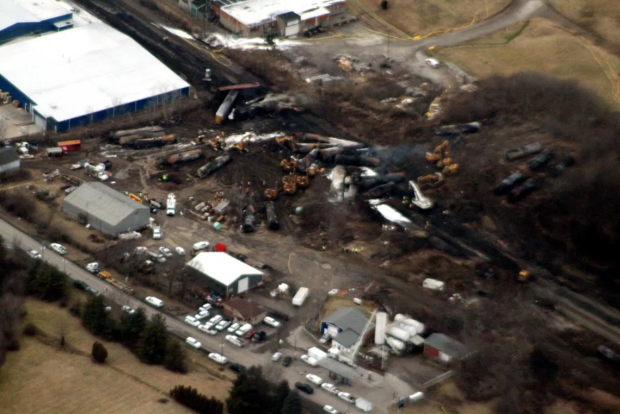Investigation Into Lingering Toxic Chemicals In Buildings After Ohio Train Derailment

Table of Contents
Types of Toxic Chemicals Released and Their Potential Long-Term Effects
The Ohio train derailment released a cocktail of dangerous chemicals, posing significant risks to the surrounding environment and the inhabitants of nearby buildings. Understanding the properties and long-term effects of these toxic chemicals is crucial for effective remediation and public health protection.
Vinyl Chloride and its Health Risks
Vinyl chloride, a known carcinogen, was among the chemicals released in significant quantities. Exposure to vinyl chloride, even at low levels, can lead to serious health consequences.
- Specific health risks: Liver cancer, brain cancer, lung cancer, lymphoma, and other circulatory system problems. Exposure during pregnancy can also lead to birth defects.
- Methods of detection: Gas chromatography-mass spectrometry (GC-MS) is a common method for detecting vinyl chloride in air and building materials. However, detecting trace amounts can be challenging.
- Long-term health studies needed: Further research is crucial to fully understand the long-term health impacts of low-level vinyl chloride exposure, particularly in relation to building contamination.
Other Hazardous Chemicals and Their Impacts
Beyond vinyl chloride, other hazardous chemicals released include butyl acrylate, ethylene glycol monobutyl ether, and others. These chemicals, while differing in their properties, share the potential for long-term building contamination and adverse health effects.
- Butyl acrylate: This chemical can cause skin and eye irritation, respiratory problems, and potentially more serious health issues with prolonged exposure. It can persist in porous materials like wood and fabrics.
- Ethylene glycol monobutyl ether: This solvent can cause irritation to the eyes, skin, and respiratory tract. Chronic exposure may lead to kidney and liver damage. It can absorb into various building materials, depending on its concentration and the material's porosity.
- Persistence in different materials: The persistence of these chemicals varies depending on factors such as the material's porosity, the chemical's volatility, and environmental conditions. Concrete may retain chemicals differently than wood or drywall.
The Challenges of Identifying and Measuring Lingering Chemicals
Identifying and measuring the precise amounts of lingering toxic chemicals in buildings presents significant challenges. Current testing methodologies have limitations in detecting trace amounts and ensuring accurate results.
- Lack of standardized testing protocols: The absence of widely accepted and standardized testing protocols makes comparison of results and interpretation of data difficult.
- Cost of testing: Comprehensive testing for a wide range of chemicals can be extremely expensive, making it a significant barrier for many homeowners and businesses.
- Time required for accurate results: Accurate testing requires specialized equipment and expertise, which can result in delays in obtaining results.
Assessment of Building Contamination and Remediation Strategies
Assessing the extent of building contamination and implementing effective remediation strategies are critical steps in protecting public health and ensuring community safety.
Methods for Detecting Chemical Contamination in Buildings
Several methods exist for detecting chemical contamination in buildings, each with its strengths and weaknesses.
- Air quality testing: This involves measuring the concentration of volatile organic compounds (VOCs) in the air, providing an indication of potential indoor contamination.
- Material sampling: This involves collecting samples of building materials (e.g., drywall, insulation, flooring) for laboratory analysis to determine the presence and concentration of specific chemicals.
- Surface analysis: This technique assesses the presence of chemicals on surfaces using methods like wipe sampling followed by laboratory analysis.
- Specific testing methods (e.g., gas chromatography-mass spectrometry): GC-MS is a powerful technique for identifying and quantifying various organic compounds in environmental samples.
Remediation Techniques for Contaminated Buildings
Remediation strategies for contaminated buildings aim to remove or mitigate the presence of toxic chemicals, ensuring a safe environment for occupants.
- Air scrubbing: This involves using specialized equipment to filter and remove contaminants from the air.
- Material removal: This involves the removal and proper disposal of contaminated building materials.
- Specialized cleaning: This involves using specialized cleaning agents and techniques to remove surface contamination.
The Role of Government Agencies and Environmental Protection
Government agencies play a crucial role in overseeing the assessment and remediation process, ensuring adherence to safety standards and protecting public health.
- EPA guidelines: The Environmental Protection Agency (EPA) provides guidelines and regulations for assessing and remediating environmental contamination.
- State-level regulations: State-level environmental agencies also play a crucial role in enforcing regulations and overseeing remediation efforts.
- Public health advisories: Public health agencies issue advisories to inform residents about potential health risks and provide guidance on safety precautions.
Long-Term Health Impacts and Community Concerns
The Ohio train derailment has raised significant concerns about the long-term health impacts on residents and the overall community well-being.
Potential Health Consequences for Residents
Exposure to lingering toxic chemicals can lead to various short-term and long-term health consequences.
- Respiratory problems: Exposure to certain chemicals can exacerbate respiratory conditions like asthma and bronchitis.
- Neurological issues: Some chemicals can affect the nervous system, causing symptoms such as headaches, dizziness, and cognitive impairment.
- Increased cancer risk: Exposure to carcinogens like vinyl chloride significantly increases the risk of developing various types of cancer.
Community Response and Advocacy
The community has responded with a range of actions to address concerns and demand accountability.
- Community organizations: Local community groups are actively involved in monitoring the situation, advocating for remediation, and providing support to affected residents.
- Legal actions: Lawsuits have been filed against the responsible parties, seeking compensation for damages and demanding stricter safety measures.
- Public health initiatives: Public health organizations are working to assess the health impacts of the derailment and provide necessary medical care and support to affected individuals.
Psychological Impacts of the Derailment
Beyond the physical health risks, the derailment has caused significant psychological distress among residents.
- Stress: The uncertainty surrounding the long-term health effects and the ongoing environmental contamination creates significant stress and anxiety.
- Anxiety: Fear of potential health problems and the impact on property values can lead to significant anxiety.
- Fear of long-term health effects: The unknown long-term consequences of exposure to toxic chemicals cause considerable fear and uncertainty.
Conclusion
The investigation into lingering toxic chemicals in buildings after the Ohio train derailment highlights the urgent need for comprehensive assessment, effective remediation strategies, and long-term health monitoring. The potential health risks associated with exposure to these chemicals are significant, emphasizing the importance of thorough investigation and community support. Key takeaways include the challenges of detecting and measuring trace amounts of toxic chemicals, the diverse range of remediation techniques, and the critical role of government agencies in overseeing the process. We must remain vigilant and advocate for stronger regulations and better safety measures to prevent similar incidents and address the lingering impacts of the toxic chemicals released in the Ohio train derailment. Contact your representatives and support organizations working to assist affected communities. Demand accountability and ensure that those responsible are held accountable for the lasting consequences of their actions. The health and safety of the community depend on it.

Featured Posts
-
 Reserva Tu Lugar Clases De Boxeo Edomex 3 Dias
May 01, 2025
Reserva Tu Lugar Clases De Boxeo Edomex 3 Dias
May 01, 2025 -
 Capital Breakfast Reveals Remember Mondays Eurovision 2025 Song
May 01, 2025
Capital Breakfast Reveals Remember Mondays Eurovision 2025 Song
May 01, 2025 -
 Daisy Midgeleys Early Career From Stripper To Corrie Star
May 01, 2025
Daisy Midgeleys Early Career From Stripper To Corrie Star
May 01, 2025 -
 England Edges France In Six Nations Thriller Thanks To Dalys Late Show
May 01, 2025
England Edges France In Six Nations Thriller Thanks To Dalys Late Show
May 01, 2025 -
 Earn 1 500 Ponants Agent Incentive For Paul Gauguin Cruise Bookings
May 01, 2025
Earn 1 500 Ponants Agent Incentive For Paul Gauguin Cruise Bookings
May 01, 2025
